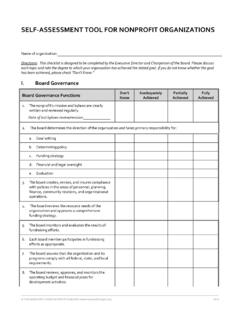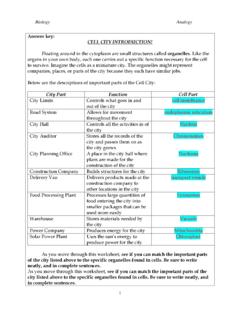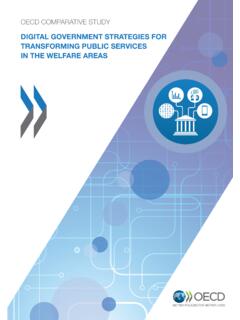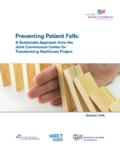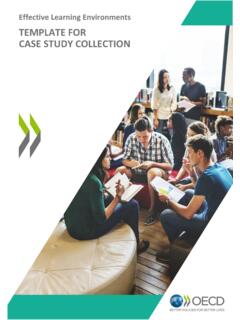Transcription of Equity & Inclusion Lens Guide - Nonprofit Association of ...
1 Equity & Inclusion lens Guide Equity & Inclusion lens Guide 2019 by Nonprofit Association of Oregon Nonprofit Association of Oregon has received generous permission from the city of Ottawa, Canada and the city for All Women Initiative (CAWI) to adapt its Equity & Inclusion lens Handbook and related toolkits as a Guide for our internal and programming interactions. NAO's Equity and Inclusion lens Guide is based on the 2018. version. To access the original source material, please visit: Third Edition: 2018; Second edition: 2015; First Edition: 2010. city of Ottawa and city for All Women Initiative (CAWI). Equity & Inclusion lens Guide 2019 by Nonprofit Association of Oregon Table of Contents A Message from NAO 02. NAO's Equity Statement 03. Why an Equity and Inclusion lens ? 04. Using This Guide 05. Terms to Get Started 06. Step 1: Consider Your Diversity 09. Step 2: Check Assumptions 11.
2 Step 3: Ask About Inclusion 13. Step 4: Apply to Your Work 14. Step 5: Be a Change Agent Take Action 15. Appendix - Applying to Your Work 16. Equity & Inclusion Worksheet 17. Communications 18. Engaging Community, Staff & Board 19. Gathering Information & Research 20. Leading & Supervising 21. Monitoring & Evaluation 22. Planning 23. Policy Development 24. Recruiting & Hiring 25. Strategic Planning 26. Training 27. Working with People 28. Public Policy 29. Equity & Inclusion lens Guide 1. 2019 by Nonprofit Association of Oregon A Message From NAO. The Nonprofit Association of Oregon's mission is to build the collective voice, leadership, and capacity of nonprofits to enrich the lives of all Oregonians. We believe the Nonprofit sector strengthens the fabric of our democracy and our communities by creating many public benefits. We believe that nonprofits have the ability to help our society to address inequities and to create innovative solutions to community issues.
3 As an organization meant to create public benefit, we recognize that our communities are diverse and so are the needs and aspirations of the people we serve. Incorporating an Equity and Inclusion lens into how we plan and deliver programs and services and how we support Nonprofit organizations, not only helps us remain relevant, meaningful and effective but ensures that we are doing so in a way that thoughtfully engages and includes individuals and communities who have been historically excluded. This lens was adapted with the generous permission from the city of Ottawa and the city for All Women Initiative from their 2018 Equity and Inclusion lens Handbook and related tools and resources. NAO requested permission to adapt this tool with the intention of sharing it with our members as a resource. We are just applying this lens within our own organization. Through refining and piloting this lens in our work, we commit to: Take positive steps to remove systemic barriers and promote Inclusion .
4 Achieve improved satisfaction of our work and services;. Create a more positive and respectful work environment; and Generate better solutions by incorporating diverse perspectives. We hope that you will find NAO's Equity & Inclusion lens Guide a useful resource and incorporate it in your daily work and reflect it in your goals and outcomes. Thank you for your commitment to a thriving and equitable Nonprofit sector! Sincerely, Brad Russell Nancy Arriaga Ramirez Jim White Board President Past President Executive Director Equity & Inclusion lens Guide 2. 2019 by Nonprofit Association of Oregon NAO's Equity Statement As the state membership organization, the Nonprofit Association of Oregon (NAO) is committed to building a more just and equitable Oregon. We recognize the history of oppression that has resulted in ongoing disparities for some communities, as well as the limitations of a Nonprofit framework to address them.
5 Yet, we have a powerful network of organizations and change agents with an opportunity before us to create positive systemic change. We believe that nonprofits that prioritize engaging diverse perspectives and evolve to be inclusive, behave equitably and have profound impacts on society. For the above reasons, NAO is committed to transforming each aspect of our organization by confronting our own biases and operationalizing our values. We know that intention alone will not change things. To this work, we bring the successes and mistakes of our own continuing efforts in the direction towards Equity on behalf of our members and all nonprofits. The mission and vision we hold for enriching the lives of all Oregonians, move us to directly challenge ourselves and to deconstruct frameworks of oppression while building opportunities for learning, change and accountability. We know: This work is urgent, and we will always be learning.
6 We will make mistakes and own our responsibility for corrective action. Our efforts will be tireless, and we will not stop. NAO is committed to our own Equity journey, the diversity of our membership and the broader Nonprofit community as change agents that contribute to an inclusive and equitable Oregon that champions our rich diversity. Approved by the Board of Directors on July 20, 2018. Equity & Inclusion lens Guide 3. 2019 by Nonprofit Association of Oregon Why an Equity & Inclusion lens ? An Equity and Inclusion lens is like a pair of glasses. It helps you see things from a new perspective. It helps you be more effective in your everyday work by getting a clearer focus and a more complete view. In turn, the full Inclusion and participation of community members and employees contributes to a vibrant society where everyone benefits. An Equity and Inclusion lens can help to: An Equity lens is Strengthen everyone's awareness of and ability to something you use daily.
7 Incorporate difference. it's essential to ensure we Create teams that are relevant to and are asking ourselves the representative of community. questions that will make us Create energizing and innovative work think about being equitable environments. and inclusive in every Collectively address systemic barriers and aspect of our work and inequities. interactions. Who is the lens for? This lens is for everyone doing the work of NAO and for everyone we work with. Nonprofit leaders, staff, board and volunteers. Community partners, consultants, funders and businesses that support nonprofits. Government organizations that partner with us and with nonprofits. Equity & Inclusion lens Guide 4. 2019 by Nonprofit Association of Oregon Using This Guide The NAO Equity & Inclusion lens Guide is an interactive tool that will help you learn about Equity and Inclusion and how to apply it to your work.
8 Change takes place in different ways and is ongoing. We are all learning. It is a lifelong process. When we consider our own diversity, check our assumptions, ask about Inclusion , and apply our insights to our work, we can create change. The end result is that we become a change agent and take action. Step 1: Consider Your Diversity Recognizing diversity within ourselves and others can help us understand how multiple factors influence the way we provide services, design policies and programs, or interact with staff and community members or stakeholders. Step 2: Check Assumptions When we question our own ideas and biases, we can open up to new ways of understanding. Keep in mind that each of us could identify with more than one group, and that individual personalities make each person unique. Step 3: Ask About Inclusion By always asking some intentional questions, we can thread Equity and Inclusion throughout our work.
9 Step 4: Apply to Your Work To help us apply Equity and Inclusion to a specific area of work, we can ask some practical questions and learn from examples of how others have applied the lens . Step 5: Be a Change Agent Take Action When we become a change agent and take action, we commit ourselves to using the information we learn in this work. It is not a one-time action. Being a change agent is a lifelong learning process of asking questions so we can apply (and re-apply) insights to action. Equity & Inclusion lens Guide 5. 2019 by Nonprofit Association of Oregon Terms to Get Started Diversity A wide range of qualities and attributes within a person, group, or community. When we celebrate diversity, communities and workplaces become richer, drawing upon the variety of experiences, perspectives, and skills that people can contribute. Assumptions Something we presuppose or take for granted without questioning it.
10 We accept these beliefs to be true and use them to interpret the world around us. Stereotypes Making assumptions about an entire group of people. We generalize all people in a group to be the same, without considering individual differences. We often base stereotypes on misconceptions or incomplete information. Bias Showing prejudice in favor of or against a person or group compared with another, usually in a way considered to be unfair. We all have both conscious and unconscious biases that shade our thinking and interactions. Inclusion Acknowledging and valuing people's differences so as to enrich or shift social planning, decision making, and quality of life for everyone. In an inclusive society, we all have a sense of belonging, acceptance, and recognition as valued and contributing members of society. Privilege The experience of unearned freedoms, rights, benefits, advantages, access, and/or opportunities afforded to members of a particular dominant group in society or in a specific context.
